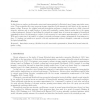Free Online Productivity Tools
i2Speak
i2Symbol
i2OCR
iTex2Img
iWeb2Print
iWeb2Shot
i2Type
iPdf2Split
iPdf2Merge
i2Bopomofo
i2Arabic
i2Style
i2Image
i2PDF
iLatex2Rtf
Sci2ools
214
Voted
NN
2011
Springer
2011
Springer
Tree-like hierarchical associative memory structures
In this letter we explore an alternative structural representation for Steinbuch-type binary associative memories. These networks offer very generous storage capacities (both asymptotic and finite) at the expense of sparse coding. However, the original retrieval prescription performs a complete search on a fully-connected network, whereas only a small fraction of units will eventually contain desired results due to the sparse coding requirement. Instead of modelling the network as a single layer of neurons we suggest a hierarchical organization where the information content of each memory is a successive approximation of one another. With such a structure it is possible to enhance retrieval performance using a progressively deepening procedure. To backup our intuition we provide collected experimental evidence alongside comments on eventual biological plausibility.
Binary Associative Memories | Neural Networks | NN 2011 | Sparse Coding | Sparse Coding Requirement |
Related Content
| Added | 17 May 2011 |
| Updated | 17 May 2011 |
| Type | Journal |
| Year | 2011 |
| Where | NN |
| Authors | João Sacramento, Andreas Wichert |
Comments (0)

